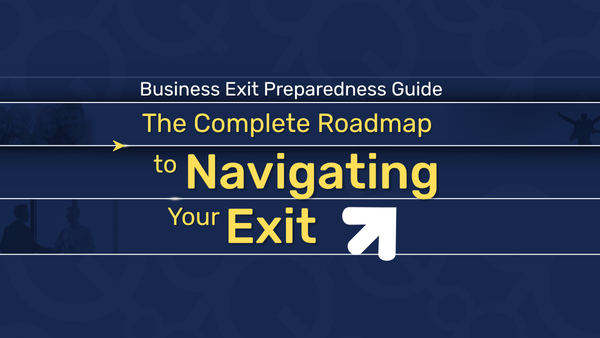When selling a business, valuation often takes center stage. Buyers and sellers negotiate numbers—multiples, EBITDA, and deal structures—but what often gets overlooked is something far more important: culture.
Your company’s identity—its values, leadership philosophy, and the way employees and clients experience the business—is a major part of what makes it successful. Yet, if cultural continuity isn’t prioritized in a sale, the very DNA of the company can erode, leading to talent loss, client churn, and declining business performance post-exit.
Buyers aren’t just acquiring revenue streams—they’re acquiring the people, processes, and culture that made the company profitable in the first place. And if that’s not preserved, neither is long-term value.
Here’s why culture matters more than cash in an exit, how it impacts business value, and how to ensure you sell to a buyer who will protect what you’ve built.
Step 1: Recognize Culture as an Asset, Not an Afterthought

Many founders see culture as intangible—hard to measure, harder to transfer. But buyers who understand long-term success know that culture is a competitive advantage.
How Culture Adds Value to a Business Sale:
✅ Stronger Employee Retention: Businesses with a defined culture see higher retention rates post-sale, reducing turnover costs.
✅ Client Loyalty & Brand Equity: A company known for trust, service, and strong values maintains customer relationships—even under new ownership.
✅ Operational Stability: A clear culture means consistent decision-making and leadership alignment, making integration smoother.
✅ Attracting the Right Buyer: Buyers who respect and align with your company’s identity are more likely to nurture its strengths rather than dismantle them.
Culture isn’t just nice to have—it’s a core asset that impacts financial success long after you’re gone.
Step 2: Assess a Buyer’s Cultural Fit, Not Just Their Financials
A buyer may have the capital to close the deal—but do they have the right mindset to run your business the way it was built?

How to Evaluate a Buyer’s Cultural Fit:
✅ Look at Their Track Record: Have they acquired businesses before? If so, did those companies retain their identity, or were they absorbed and rebranded?
✅ Have Candid Conversations: Don’t just negotiate financials—ask potential buyers about their leadership philosophy, employee engagement strategies, and commitment to culture continuity.
✅ Talk to Their Past Acquisitions: Speak with business owners they’ve acquired. Did they keep the company’s core values intact, or did they overhaul leadership and processes?
✅ Assess Their Long-Term Intentions: Are they buying to build on what you’ve created or to flip and restructure for short-term gains?
The right buyer isn’t just someone with the highest bid—it’s someone who understands why your company’s culture makes it valuable in the first place.
Step 3: Structure the Deal to Protect Cultural Continuity

Even if you find a culturally aligned buyer, you still need contractual safeguards to ensure your company’s identity doesn’t disappear post-sale.
Ways to Preserve Culture in the Sale Agreement:
✔️ Leadership Transition Plan: Require that the buyer retain key leadership roles for a defined period to maintain cultural stability.
✔️ Brand Protection Clauses: If your company name, mission, or branding is central to its success, include clauses that protect it from immediate change.
✔️ Employee Retention Agreements: Structure the deal with incentives or contractual agreements to ensure key employees stay for at least 12-24 months post-sale.
✔️ Advisory Role for the Founder: Negotiate a consulting or board position for yourself post-sale to oversee the transition and ensure cultural continuity.
When culture is woven into the deal structure, it becomes a measurable part of the exit strategy—not just an expectation.
Step 4: Communicate Culture as a Priority to Employees & Clients
Employees and clients often worry that a sale means loss of identity—that the company they trust will change in ways they don’t want. If they aren’t reassured, they may leave before the transition even happens.

How to Communicate Cultural Continuity:
✅ Be Transparent About the Buyer’s Intentions: Share why you chose this buyer and how they align with the company’s values.
✅ Involve Leadership Early: Ensure senior managers are part of the transition discussions so they can champion culture during the handover.
✅ Set Clear Cultural Expectations for New Ownership: Provide a culture handbook outlining core values, leadership principles, and customer service philosophies.
✅ Introduce the Buyer Thoughtfully: Host meet-and-greet sessions, Q&A forums, or leadership summits to ensure employees and clients feel connected to the transition.
A well-communicated transition builds trust, stability, and confidence, reducing uncertainty and preventing talent or client loss.
Selling a Business is About More Than Money
The best deals aren’t just measured in dollars—they’re measured in what happens to the company after you leave.
A high sale price means nothing if:
❌ Employees leave en masse due to culture shifts.
❌ Clients lose trust in the brand and take their business elsewhere.
❌ Your company’s legacy is erased in a restructuring.
By prioritizing culture alongside financial value, you ensure that your business continues to thrive under new ownership—while securing an exit that truly reflects your vision, values, and hard work.
If you’re planning your exit and want to ensure your company’s identity remains intact, start building culture into your transition strategy now. The right buyer isn’t just someone who pays the most—it’s someone who believes in what you’ve built and is committed to preserving it.







